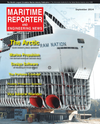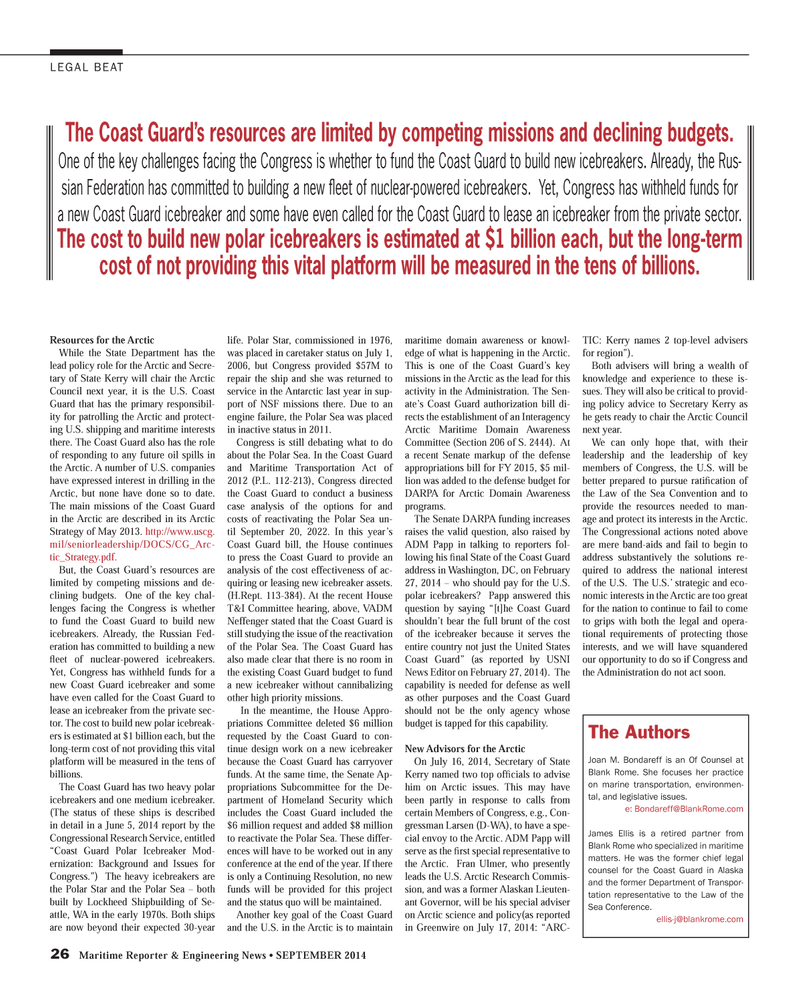
Page 26: of Maritime Reporter Magazine (September 2014)
Marine Propulsion Edition
Read this page in Pdf, Flash or Html5 edition of September 2014 Maritime Reporter Magazine
26 Maritime Reporter & Engineering News • SEPTEMBER 2014
Resources for the Arctic
While the State Department has the lead policy role for the Arctic and Secre- tary of State Kerry will chair the Arctic
Council next year, it is the U.S. Coast
Guard that has the primary responsibil- ity for patrolling the Arctic and protect- ing U.S. shipping and maritime interests there. The Coast Guard also has the role of responding to any future oil spills in the Arctic. A number of U.S. companies have expressed interest in drilling in the
Arctic, but none have done so to date.
The main missions of the Coast Guard in the Arctic are described in its Arctic
Strategy of May 2013. http://www.uscg. mil/seniorleadership/DOCS/CG_Arc- tic_Strategy.pdf.
But, the Coast Guard’s resources are limited by competing missions and de- clining budgets. One of the key chal- lenges facing the Congress is whether to fund the Coast Guard to build new icebreakers. Already, the Russian Fed- eration has committed to building a new fl eet of nuclear-powered icebreakers.
Yet, Congress has withheld funds for a new Coast Guard icebreaker and some have even called for the Coast Guard to lease an icebreaker from the private sec- tor. The cost to build new polar icebreak- ers is estimated at $1 billion each, but the long-term cost of not providing this vital platform will be measured in the tens of billions.
The Coast Guard has two heavy polar icebreakers and one medium icebreaker. (The status of these ships is described in detail in a June 5, 2014 report by the
Congressional Research Service, entitled “Coast Guard Polar Icebreaker Mod- ernization: Background and Issues for
Congress.”) The heavy icebreakers are the Polar Star and the Polar Sea – both built by Lockheed Shipbuilding of Se- attle, WA in the early 1970s. Both ships are now beyond their expected 30-year life. Polar Star, commissioned in 1976, was placed in caretaker status on July 1, 2006, but Congress provided $57M to repair the ship and she was returned to service in the Antarctic last year in sup- port of NSF missions there. Due to an engine failure, the Polar Sea was placed in inactive status in 2011.
Congress is still debating what to do about the Polar Sea. In the Coast Guard and Maritime Transportation Act of 2012 (P.L. 112-213), Congress directed the Coast Guard to conduct a business case analysis of the options for and costs of reactivating the Polar Sea un- til September 20, 2022. In this year’s
Coast Guard bill, the House continues to press the Coast Guard to provide an analysis of the cost effectiveness of ac- quiring or leasing new icebreaker assets. (H.Rept. 113-384). At the recent House
T&I Committee hearing, above, VADM
Neffenger stated that the Coast Guard is still studying the issue of the reactivation of the Polar Sea. The Coast Guard has also made clear that there is no room in the existing Coast Guard budget to fund a new icebreaker without cannibalizing other high priority missions. In the meantime, the House Appro- priations Committee deleted $6 million requested by the Coast Guard to con- tinue design work on a new icebreaker because the Coast Guard has carryover funds. At the same time, the Senate Ap- propriations Subcommittee for the De- partment of Homeland Security which includes the Coast Guard included the $6 million request and added $8 million to reactivate the Polar Sea. These differ- ences will have to be worked out in any conference at the end of the year. If there is only a Continuing Resolution, no new funds will be provided for this project and the status quo will be maintained.
Another key goal of the Coast Guard and the U.S. in the Arctic is to maintain maritime domain awareness or knowl- edge of what is happening in the Arctic.
This is one of the Coast Guard’s key missions in the Arctic as the lead for this activity in the Administration. The Sen- ate’s Coast Guard authorization bill di- rects the establishment of an Interagency
Arctic Maritime Domain Awareness
Committee (Section 206 of S. 2444). At a recent Senate markup of the defense appropriations bill for FY 2015, $5 mil- lion was added to the defense budget for
DARPA for Arctic Domain Awareness programs.
The Senate DARPA funding increases raises the valid question, also raised by
ADM Papp in talking to reporters fol- lowing his fi nal State of the Coast Guard address in Washington, DC, on February 27, 2014 – who should pay for the U.S. polar icebreakers? Papp answered this question by saying “[t]he Coast Guard shouldn’t bear the full brunt of the cost of the icebreaker because it serves the entire country not just the United States
Coast Guard” (as reported by USNI
News Editor on February 27, 2014). The capability is needed for defense as well as other purposes and the Coast Guard should not be the only agency whose budget is tapped for this capability.
New Advisors for the Arctic
On July 16, 2014, Secretary of State
Kerry named two top offi cials to advise him on Arctic issues. This may have been partly in response to calls from certain Members of Congress, e.g., Con- gressman Larsen (D-WA), to have a spe- cial envoy to the Arctic. ADM Papp will serve as the fi rst special representative to the Arctic. Fran Ulmer, who presently leads the U.S. Arctic Research Commis- sion, and was a former Alaskan Lieuten- ant Governor, will be his special adviser on Arctic science and policy(as reported in Greenwire on July 17, 2014: “ARC-
TIC: Kerry names 2 top-level advisers for region”).
Both advisers will bring a wealth of knowledge and experience to these is- sues. They will also be critical to provid- ing policy advice to Secretary Kerry as he gets ready to chair the Arctic Council next year.
We can only hope that, with their leadership and the leadership of key members of Congress, the U.S. will be better prepared to pursue ratifi cation of the Law of the Sea Convention and to provide the resources needed to man- age and protect its interests in the Arctic.
The Congressional actions noted above are mere band-aids and fail to begin to address substantively the solutions re- quired to address the national interest of the U.S. The U.S.’ strategic and eco- nomic interests in the Arctic are too great for the nation to continue to fail to come to grips with both the legal and opera- tional requirements of protecting those interests, and we will have squandered our opportunity to do so if Congress and the Administration do not act soon.
The Authors
Joan M. Bondareff is an Of Counsel at
Blank Rome. She focuses her practice on marine transportation, environmen- tal, and legislative issues. e: [email protected]
James Ellis is a retired partner from
Blank Rome who specialized in maritime matters. He was the former chief legal counsel for the Coast Guard in Alaska and the former Department of Transpor- tation representative to the Law of the
Sea Conference. [email protected]
LEGAL BEAT
The Coast Guard’s resources are limited by competing missions and declining budgets.
One of the key challenges facing the Congress is whether to fund the Coast Guard to build new icebreakers. Already, the Rus- sian Federation has committed to building a new fl eet of nuclear-powered icebreakers. Yet, Congress has withheld funds for a new Coast Guard icebreaker and some have even called for the Coast Guard to lease an icebreaker from the private sector.
The cost to build new polar icebreakers is estimated at $1 billion each, but the long-term cost of not providing this vital platform will be measured in the tens of billions.
MR #9 (26-33).indd 26 9/3/2014 9:52:23 AM

 25
25

 27
27
